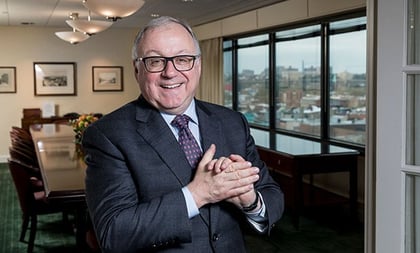We caught up with thought leader Mark Tibergien during the Pershing RIA Symposium in Chicago on Thursday. Tibergien, CEO of BNY Mellon’s Pershing Advisor Solutions, discussed the RIA-zation of the business, key challenges going forward, and what’s next on the horizon for RIAs.
The good news is the business will continue to grow, he believes. Tibergien noted that after the financial crisis of 2008 to 2010, “People woke up and said, ‘I need to trust my financial professional. I need somebody who is acting on my behalf, and not acting on their firm’s behalf.’ So they started to seek out fiduciary advisors to work with.”
He says they personally saw this shift at BNY Mellon Pershing, which today holds $33 trillion in assets globally and is the largest custodian in the world. “In 2010, Pershing had $53 billion of fiduciary assets on its platform,” Tibergien said. “Today we have almost $650 billion.” Much of that growth, he says came from individual advisory firms, but also from “independent broker-dealers who created corporate RIAs to provide the same service.”
He says when looking at the market, “you can see this evolution toward a fiduciary model, regardless of DOL’s legislation or best-interest contract. It’s behavior, not rules, that’s changing the way in which [RIAs] think, because they have to engage clients differently.”
He points out a recent Cerulli survey that found that by 2020, the RIA segment of the retail financial services business will be 30% of the marketplace. Today it’s about 21%.
He also points out another study finding that there are more employees who are advisors than principals who are advisors.
“The reason that’s significant is because in many respects, the RIA model is replacing the elements of the independent contractor broker-dealer,” Tibergien said. “So today there are over 650 RIA firms that have over $1 billion of assets under management. And a number of them have over $5 billion, and some have over $10 billion [in AUM].”
Is that wealth due to new money sloshing around in the markets? Tibergien says he’s not sure that can be directly linked to RIA business growth, but he believes it contributed to the growth of financial services. “To not be in the financial services business, you’re missing an opportunity. There’s a reason there are so many private equity firms that are investing in broker-dealers and RIAs,” he says.
He does believe there could be potential disruptors to the business, such as regulation that has unintended consequences; he says the RIA business needs a consolidated and stronger voice in Washington.
Storm Clouds Ahead
Of course, a key challenge in the industry is the talent shortage, and Tibergien says it has been “for a long time.” But he’s also concerned about the age, gender and ethnic demographics of the business. He noted that only 1.5% of certified financial planners are African-American, and only 8% are people of color. Further, only 23% are women.









 September 21, 2018 at 04:39 PM
September 21, 2018 at 04:39 PM











